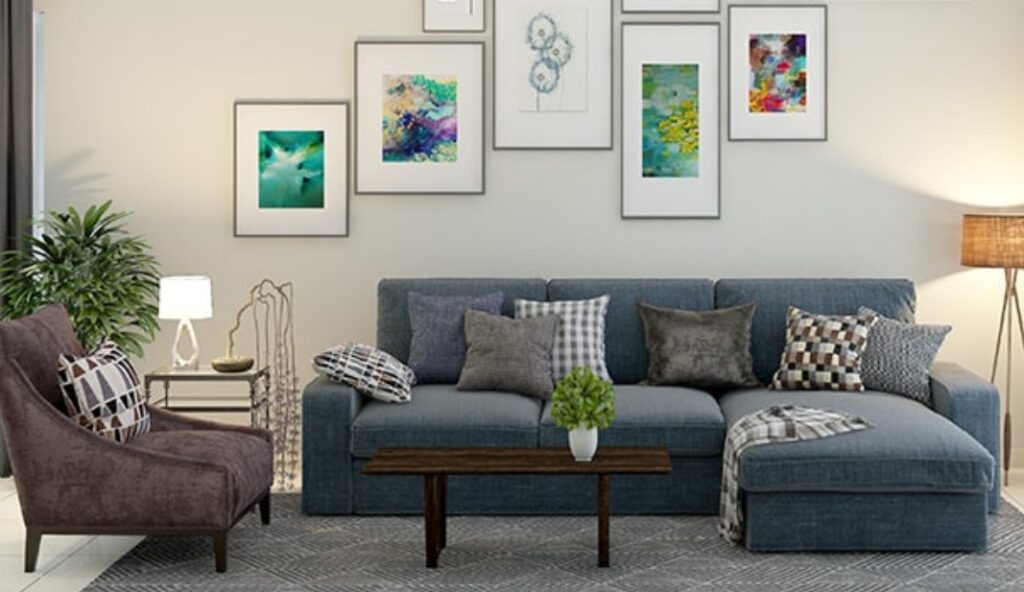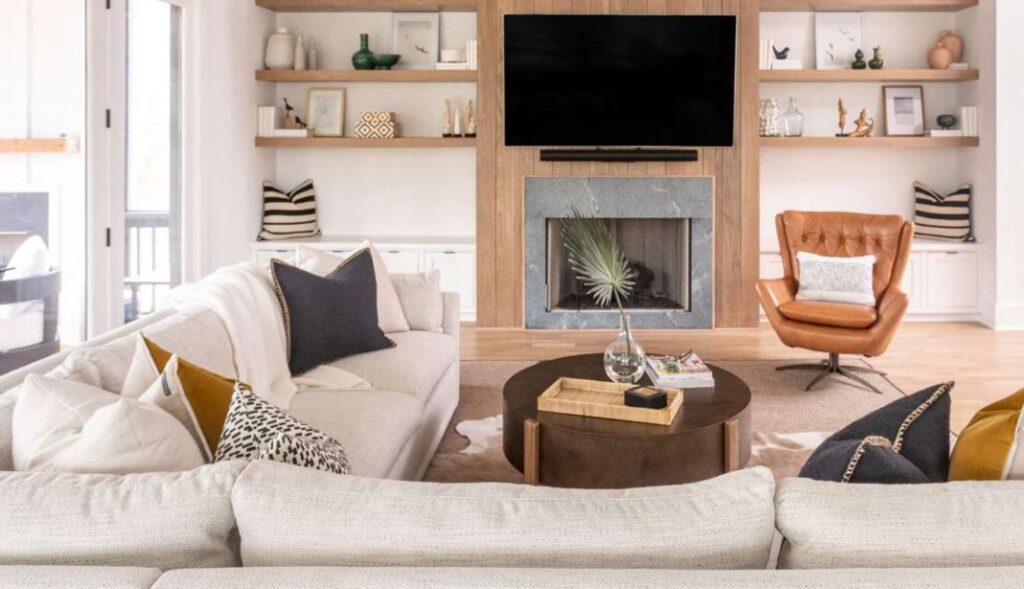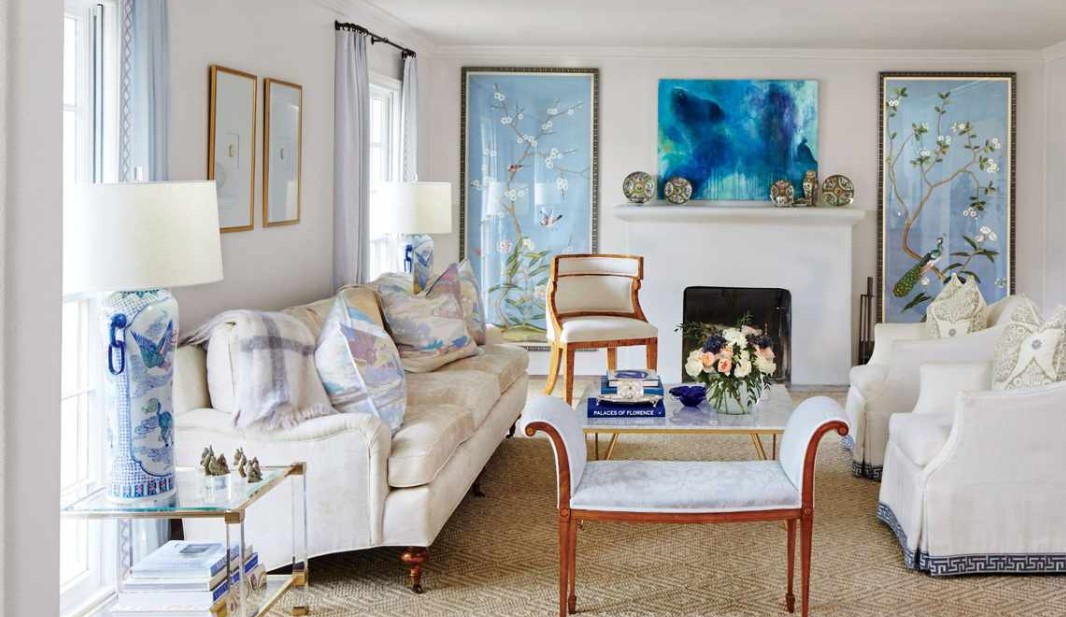Creating the perfect living room space is an art form that combines personal taste, functionality, and a keen eye for design. Wall decor plays a crucial role in transforming your living room into a welcoming, stylish, and comfortable environment. This comprehensive guide will explore various wall decor ideas that will help you achieve a visually stunning living room.
1. The Importance of Wall Decor in Living Room Design

The living room is often considered the heart of the home, a space where we entertain guests, relax with family, and spend much of our leisure time. The design of this room is therefore crucial in setting the tone for the entire home. One of the most impactful aspects of living room design is wall decor. By thoughtfully selecting and arranging wall decor, we can transform a bland room into a stylish and inviting space. In this article, we will explore the various elements of wall decor and their importance in living room design.
Creating a Focal Point
Every well-designed living room needs a focal point—a place where the eyes naturally fall upon entering the room. Wall decor plays a significant role in establishing this focal point. A large piece of artwork or a stunning gallery wall can instantly draw attention and set the tone for the rest of the room.
When selecting artwork, it’s important to consider the size and scale. A piece that is too small can get lost on a large wall, while one that is too large can overwhelm the space. The key is to find a balance that complements the room’s proportions. Bold colors and dynamic compositions can create visual interest and make the focal point stand out.
Enhancing Style and Personality
Wall decor is an excellent way to infuse a living room with personal style and character. Whether you prefer modern, minimalist designs or a more eclectic, bohemian vibe, the right wall decor can reflect your unique tastes.
Photographs, prints, and posters can showcase personal interests and memories. Custom framing can add an extra touch of elegance and cohesion to the display. For a more eclectic look, consider mixing different types of wall decor, such as mirrors, textiles, and sculptures. This approach can create a layered and interesting visual narrative.
Improving Spatial Perception
Strategically placed wall decor can also influence how we perceive the size and shape of a room. Mirrors, for example, are a classic design tool for making a space feel larger and more open. By reflecting light and views, mirrors can create an illusion of depth and expansiveness.
Similarly, the arrangement of wall decor can guide the flow of the room. Vertical arrangements can make ceilings appear higher, while horizontal arrangements can make the room feel wider. This is particularly useful in smaller living rooms, where maximizing space is essential.
Adding Color and Texture
Wall decor is a versatile way to introduce color and texture into a living room. While furniture and textiles contribute to the overall palette, wall decor can provide the finishing touch that ties everything together.
A colorful piece of art can inject vibrancy into a neutral room, while a textured wall hanging can add warmth and depth. When choosing wall decor, consider how the colors and textures will interact with the existing elements in the room. Coordinating or contrasting these elements can create a cohesive and visually appealing design.
Cultural and Personal Expression
Incorporating wall decor that reflects your cultural background or personal interests can make your living room feel more authentic and meaningful. Items such as cultural artifacts, travel souvenirs, and handcrafted pieces can tell a story and add a unique touch to your space.
Gallery walls featuring a mix of photographs, art, and mementos can serve as a personal timeline, showcasing important moments and milestones. This not only adds visual interest but also makes the living room feel more intimate and personalized.
Practical Considerations
While aesthetics are crucial, it’s also important to consider the practical aspects of wall decor. The durability and maintenance of materials should be taken into account, especially in a high-traffic area like the living room. Framed artwork, for example, can be protected with glass to prevent damage, while washable wall hangings can be a practical choice for families with children or pets.
Lighting is another practical consideration. Proper lighting can enhance the impact of wall decor, highlighting its features and creating the desired ambiance. Accent lighting, such as picture lights or sconces, can be used to draw attention to specific pieces, adding both functionality and aesthetic appeal.
The importance of wall decor in living room design cannot be overstated. It plays a critical role in creating a focal point, expressing personal style, improving spatial perception, adding color and texture, and reflecting cultural and personal identity. By carefully selecting and arranging wall decor, we can transform the living room into a space that is not only beautiful and inviting but also reflective of our unique tastes and experiences.
2. Choosing the Right Wall Art

Wall art is a fundamental element of interior design that can significantly enhance the aesthetic appeal and ambiance of any room. Selecting the perfect wall art requires careful consideration of various factors, including the room’s overall design, color scheme, size, and personal preferences. This article delves into the essential aspects of choosing the right wall art to elevate your living space.
Understanding Your Space
Before purchasing wall art, it’s crucial to understand the space where the art will be displayed. Consider the room’s function, size, and existing decor. For instance, a large piece of art can be the centerpiece in a spacious living room, while smaller, complementary pieces might be more suitable for a bedroom or hallway.
Room Function and Style
The function of the room plays a vital role in selecting appropriate wall art. In a living room, where you entertain guests, you might opt for bold and eye-catching pieces that spark conversation. In contrast, a bedroom may benefit from more serene and calming artwork that promotes relaxation.
Consider the room’s style—whether it’s modern, traditional, rustic, or eclectic. The wall art should complement and enhance this style rather than clash with it. For a modern space, abstract art with clean lines and minimalistic designs can be ideal. For a traditional room, consider classic paintings or vintage prints.
Size and Placement
Size is another critical factor in choosing wall art. A common rule is that the art should take up about two-thirds to three-quarters of the wall space above a piece of furniture. For instance, above a sofa or bed, the artwork should not be wider than the furniture piece itself.
When it comes to placement, eye level is generally a good rule of thumb. In a living room, the center of the artwork should be about 57 to 60 inches from the floor, ensuring it’s easily viewable whether you’re standing or sitting.
Considering Size and Scale
The size and scale of your wall art should be proportional to the wall space. Large pieces are ideal for expansive walls, creating a dramatic impact. Conversely, smaller artworks can be grouped to form a cohesive gallery wall. Ensure there is enough spacing between each piece to maintain balance and avoid a cluttered look.
3. Incorporating Mirrors for Depth and Light

Using Mirrors Strategically
Mirrors are a versatile addition to any living room. They not only enhance the room’s brightness by reflecting light but also create an illusion of more space. Place mirrors opposite windows to maximize natural light or behind light sources to amplify their effect.
Choosing Decorative Mirrors
Decorative mirrors come in various shapes, sizes, and frame styles. A large, ornately framed mirror can serve as a statement piece, while a collection of smaller, uniquely shaped mirrors can add an artistic touch. Consider mirrors with interesting frames that match your living room’s decor for a cohesive look.
4. Creating a Gallery Wall

Planning Your Gallery Wall Layout
A gallery wall is an excellent way to showcase multiple pieces of art, photographs, and other wall decor items. Start by planning the layout on the floor before hanging anything on the wall. Use paper templates to visualize the arrangement and ensure the spacing between each piece is uniform.
Mixing and Matching Frames
Mixing and matching frames can add visual interest to your gallery wall. Combine different textures, colors, and sizes to create a dynamic display. However, maintain a common theme or color palette to ensure the gallery wall looks cohesive and intentional.
5. Utilizing Shelves and Ledges
Floating Shelves for Versatility
Floating shelves are a stylish and functional option for displaying various decor items. They can hold picture frames, small sculptures, plants, and other decorative objects. Arrange items of different heights and textures to create an eye-catching display.
Picture Ledges for Easy Updates
Picture ledges are shallow shelves designed to hold framed artworks and photos. They are perfect for those who like to update their decor frequently, as you can easily swap out pieces without needing to rehang them. Stack multiple ledges for a layered look.
6. Adding Texture with Wall Hangings
Tapestries and Fabric Art
Tapestries and fabric art add texture, warmth, and a bohemian touch to your living room. They are available in various designs, from intricate patterns to minimalist designs. Hang a large tapestry as a focal point or layer smaller ones for a textured look.
Woven Wall Hangings
Woven wall hangings are a popular choice for adding texture and depth. These handcrafted pieces come in various styles, from macramé to woven wool. They can soften the look of a room and add a tactile element to your wall decor.
7. Incorporating Natural Elements
Greenery and Plant Displays
Bringing nature indoors can enhance the living room’s ambiance. Use wall-mounted planters or hanging pots to display greenery. Plants not only add color and life but also improve air quality and create a calming atmosphere.
Natural Wood Accents
Natural wood accents, such as reclaimed wood shelves or wooden wall art, add warmth and a rustic charm to your living room. The natural grains and textures of the wood can create a beautiful contrast with other decor elements.
8. Personalizing with Photos and Memorabilia
Creating a Photo Wall
A photo wall filled with personal photos can make your living room feel more intimate and personalized. Use uniform frames for a cohesive look, or mix different styles for a more eclectic vibe. Arrange the photos in a grid or a more free-form layout, depending on your preference.
Displaying Memorabilia
Incorporate memorabilia such as travel souvenirs, family heirlooms, or favorite collectibles into your wall decor. These items add a unique, personal touch and can serve as great conversation starters.
9. Using Wall Decals and Stickers
Temporary and Versatile Decor
Wall decals and stickers are a fantastic option for those who want a temporary or easily changeable decor solution. They come in various designs, from simple patterns to elaborate murals. Decals are easy to apply and remove, making them ideal for renters or those who frequently update their decor.
Creating Accent Walls
Use wall decals to create an accent wall that draws attention and adds character to your living room. Choose designs that complement your existing decor and color scheme for a harmonious look.
10. Enhancing with Lighting
Wall Sconces for Ambiance
Wall sconces are an elegant way to add ambient lighting to your living room. They come in various styles, from modern to vintage, and can be used to highlight specific decor elements or create a cozy atmosphere. Place them strategically to enhance the room’s overall lighting.
String Lights for a Cozy Touch
String lights add a warm, inviting glow to your living room. Drape them across a wall, around a mirror, or along a shelf to create a cozy, whimsical effect. They are perfect for adding a touch of magic to your decor.
11. Staying True to Your Style
While it’s important to consider various decor trends and ideas, staying true to your personal style is paramount. Your living room should be a reflection of your taste and personality. Combine different elements that resonate with you and create a space that you love spending time in.
Creating a beautiful and inviting living room with the right wall decor is an enjoyable and rewarding process. By incorporating these ideas, you can transform your living room into a stylish, comfortable, and personalized space that truly feels like home.
